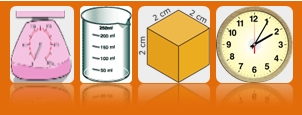Measurement for primary
|
The key understandings in measurement are recognising that objects have attributes and these attributes can be measured using units. Check out A Maths Dictionary for Kids to explore the language of mathematics. Worksheet wizard generates printable worksheets for practice in measuring length in mm, cm and km, as well as perimeter and capacity. Interactive calendars and clocks are a fun way to learn to tell time. For Interactive White Board resources, explore SMART exchange. Use the site Primary Resources for measurement at all stages of learning. Another great source of explanations, diagrams and worksheets is Math is Fun. ABC Education has videos, teaching notes and a variety of activities, like this one about the length of a year and how many seasons there are in different parts of Australia, or measuring different things. |
Balance different shapes at Guess the Weights and practice measuring in cm. Use the language of length to order height. Visit Mathsframe to read hour times on an analog clock. It's important at this stage to ground the discussion in the physical world, so make sure that you are giving students opportunities to measure and order physical objects. If each student brings in an interesting item, a useful series of small group activities might be to ask a group of students to think of different properties to measure, and order the objects in reference to each property, ie order the objects by weight, length, height.
Feed the mouse while telling time, or measure and record mass at ICT games. Read lengths in centimetres at funbrain and find the perimeter and area of rectangles. This interactive scale will let you practice reading different scales, both grams and kilograms. This page describes an interesting technique for estimating distance, which could be used for a good discussion about estimation and accuracy. |
Learn a cool method of measuring a tree without a ladder, and discover the relationship between volume and displacement. Can you read a graduated cylinder? — try these quizzes and practice using litres and millilitres. Learn about converting between different systems of measurement. Try these measurement puzzles from Math is Fun. Always make links to the physical world. When students measure physical objects, they have to decide where to measure from, and how accurate they want to be, and this can start useful discussions.
See also Sites2See pages for Number, Patterns and Algebra and Space and Geometry for Primary. |

